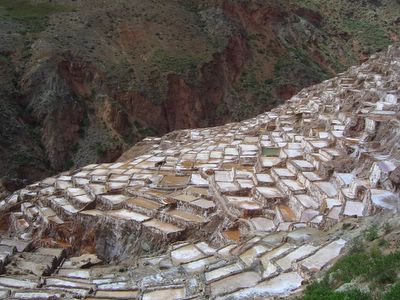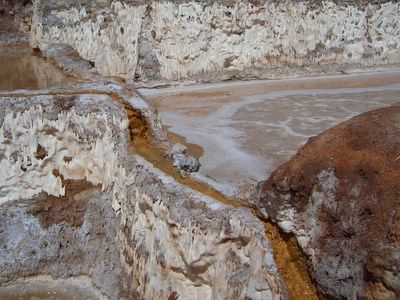Diane: Another day of exquisite walking. This time to two Incan sites: one an Incan legacy and the other an Incan mystery. The Incas took a warm salty spring and by building thousands of terraced pools, created a salt mine, which is still in operation today.
Sunlight evaporates the water in each pool, leaving a thin layer of salt. There are narrow paths that crunch underfoot as one explores the pools. The vertical sections of the terraces are covered with thick deposits of salt, creating a patchwork of crystalline sculpture.

Although the pools cover an immense area of hillside, the spring itself does not have that large a flow. By the time it reaches some of the lower pools, it looks more like wet mud than the source of a terraced wonder.
These salt pools are not enigmatic. Unlike many of the ruins we have seen, there are no large unanswered questions, such as "Did slave labor build these enormous, elaborate constructions?" or "Did they use that carved channel in the rock for warm llama blood or warm human blood?" or "Is that rock supposed to represent a condor, a serpent, a guinea pig, or a mountain?" Since the mine has been in continuous operation, the explanations are far more straightforward: the local people work the mine and salt is exported.
Today, some construction was going on across the gorge at the top of the facing mountain. Large boulders were being pushed off the edge, creating small avalanches as they bounced and rolled to the bottom of the gorge. The salt pools provided front row seats.
All of the directions we had received were a bit sketchy, but having tanked up on Kola Real, an awful-tasting Peruvian soda, we were ready to tackle the long, dusty, unknown road to Moray.
We stopped for a break near some sort of large power or communications tower. Miki went over to see if perhaps his cell phone would get a signal. Cell phone communication is a bit different here in Peru than it is at home. There are tons of telephone stores; even street vendors sell cell phones. Lots of people carry cell phones, but almost nobody has any minutes. Once in a while you'll actually see someone talking on a cell phone, but for the most part, people tend to check them frequently, read the display, dial a lot of numbers, and make funky cell phone music with the multitude of rings available. Rather than talk on a cell phone, the majority of communication involves text messaging. Even I tried this out, when we left Chiclayo. By logging on to a special account, I used the internet to send a text message to Miki's phone. Today, Miki was looking for an opportunity to check his text messages, since he wasn't getting any signal in Ollantaytambo, where we are staying.
While I'm on the subject, I'll mention that people here also use the internet to communicate in a slightly different manner than we do in the U.S. Everybody uses MSN Messenger to chat, which they just call Messenger. In the ubiquitous internet cafes that can be found in almost every city, town, and village in Peru, if I glance over at someone else's monitor, I am more likely than not to see either Messenger or Hotmail up on their screen. Many people also use Messenger in combination with a headset and microphone to have the equivalent of a phone conversation with their buddies. Although I don't intend to eavesdrop on others, it is almost impossible to avoid, due to the fact that the machines are generally lined up very close to one another.
So, here's the difference. In the U.S., most of the people I know use their personal email to communicate with others at their convenience - when the baby is napping for half an hour, in the middle of the night when they can't sleep, perhaps early in the morning when their friends are still asleep. You don't really have a full-fledged dialog, but you have more frequent contact. Additionally, you can let many people know what's going on, when there's a major life event, e.g. a death, a birth, or how you felt when Kerry lost the last election. But in Peru, people use the internet for real-time communications, chatting away on Messenger.
And now, back to our walk.
After a bit of probing on my part, it turns out that Miki had received a text message from his girlfriend of 5 years. They had had a fight on Messenger a couple of days ago and now she was evidently breaking up with him with a text message. These text messages only support a couple of hundred characters (256?), so she must have been very succinct. TM maintains that last fall, one of his friends was dumped over IM (the chatting application most popular in the U.S.). And here we have one of the more unimaginative, wimping-out uses of the latest technology.
We did finally arrive in Moray and we were not disappointed. We had seen pictures of Moray's perfect circular terracing. Unlike the clearcut nature of the salt mine, these terraces were a bit of a mystery.
The first and largest terraced sinkhole we came to, looked like an amphitheater. But, they say it ain't so. The latest theory holds that Moray was an agricultural research station. It was built to create different microclimates with gradations of sun, shade, elevation, and therefore temperature as well. The perfect irrigation channels from terrace to terrace, and the discovery of different seeds on different terraces support this theory.
Scientists hypothesize that this might be where the Incas learned to grow corn and potatos in a variety of conditions, which would have provided them the ability to expand their empire.
We passed a professional videographer on our way down to the bottom of the sinkhole. When we arrived, Miki sat down in the center to compose a letter to his now ex-girlfriend. I starting putting together apple and cheese sandwiches.
Tom took our picture. And, Calliope set her attention on the videographer, who was now filming us, and the narrator who thought we were preparing for a spiritual journey or at least an offering to Pachamama. There's a rather coarse line between spiritual rituals and eating, but I have confidence that they will realize their mistake before airing this footage.
If you click on the photo above and enlarge it as much as you can, you'll be able to see us more clearly. Additionaly, you can see the zigzag steps that lead from one terrace to the next. We had to take huge steps to descend. The indigenous people here are very, very short, so we are all a bit confounded as to why the Incas would create steps that appear to be designed for long-legged people.
Shortly after arriving at the bus station to take our return bus to Ollantaytambo, Miki's cell phone rang. In a very unusual move, he actually answered the phone. We found our way to the proper bus and Miki ended his conversation, just as we started to board. He and his girlfriend had reunited! A joyful ending to a delightful day.

No comments:
Post a Comment